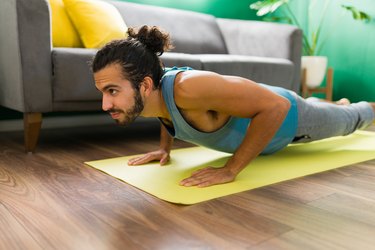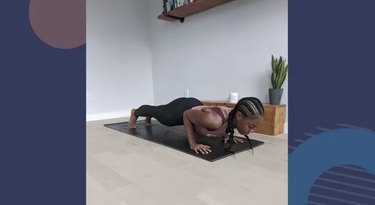
If you've ever been to a Vinyasa yoga class, chances are, you've experienced the challenging pose known as Chaturanga Dandasana.
As a foundational asana that's also apart of the sun salutations, Chaturanga Dandasana (also referred to as four-limbed staff pose) is the yoga version of a push-up. It strengthens your abdominals, as well as your arms and wrists and prepares you for more advanced poses, like arm balances and inversions.
Video of the Day
No matter whether you're a seasoned yogi, have recently started your practice or fall anywhere in between, Chaturanga is a pose that many people struggle. That's because it's a powerful pose that recruits many muscles in the body and requires a considerable amount of strength to perform.
So, if you're someone who struggles with finding stability in Chaturanga, we explain the four main reasons why and exactly how to fix them.
If You: Have Shoulders That Hunch Up Toward Your Ears
You Might: Have Poor Posture
If you spend time typing on a computer all day or constantly looking down on your phone texting and scrolling through social media, you'll want to incorporate yoga poses that not only straighten out your posture but also strengthen and open your chest.
Fix It
When you sit or stand in everyday life, try to remember to roll your shoulders down and back away from your ears. Doing so can help prevent a rounded or hunched back.
Additionally, foundational poses like cat-cow, plank, cobra and downward facing dog are excellent with helping to correct posture.
Hold these poses for 5 to 10 breaths.
Cat-Cow Pose
- Start on all fours with your knees under your hips and your hands under your shoulders.
- Exhale as you round your back, pull your belly button toward your spine and tuck your chin toward your chest.
- Drop your belly towards the floor or mat while inhaling. Lift your chin and chest while looking toward the ceiling. You can drop your belly fully to create a deep curve in your back if it's comfortable to do so. Move slower or more gently if a full curve would be uncomfortable
- Then reverse the motion to continue to move between cat and cow pose, letting your body move with your breath.
Plank Pose
- Lie face down on your belly with your palms on the floor underneath your shoulders and your feet flexed with the bottoms of your toes on the floor.
- Take a deep breath and press through your palms to lift yourself up into the top of a push-up position. Your body should make a straight line from your heels through your hips to the top of your head.
- Draw your navel toward your spine and squeeze your glutes.
- Look at the floor directly below your head to keep your neck in a neutral position and breathe normally.
Downward Facing Dog Pose
- Start on all fours, tuck your toes under and lift your hips up, straightening your legs.
- Draw your shoulders down your back away from your ears. Elongate your spine and extend the backs of your legs only as far as your hamstrings allow.
- Depending on your flexibility, bring your heels down toward the mat or stay on the balls of your feet with your knees bent.
- After a few breaths, bring your knees back down to the ground in the starting position.
If You: Experience Neck Pain
You Might: Need to Redirect Your Gaze and Properly Align Your Body
While this can also be related to having poor posture, it's also important to note that if you look down too far (tucking your chin into your chest), your head falls forward. This causes your head to feel heavier and out of alignment.
As a result, this increases the load on your neck and upper back muscles, causing them to become inflamed and excessively tight, which can lead to pain.
Fix It
Set your gaze to the floor and slightly forward and aim to achieve proper alignment in Chaturanga.
Chaturanga Dandasana

- From a high plank, slowly lower your body down halfway, so you're hovering a few inches above the floor.
- Press your hands down into your mat, keep the elbows planted firmly by your sides and set your gaze slightly forward.
Tip
You can modify Chaturanga Dandasana by dropping your knees to the floor or lowering your hips toward the floor to decrease the intensity of the pose. If needed, you can also place your forearms onto the mat as well.
If You: Have Elbows That Flare Outward
You Might: Need to Strengthen or Engage Your Wrists
This can also can be related to lacking upper body strength as well. However, if your elbows splay out to the sides of your yoga mat, rather than the sides of your body, you may not be engaging your wrists, or you may lack strength in your wrists.
Additionally, depending on what you do throughout the day, if you spend a lot of time time writing typing or driving, your wrists are bending forward with no additional weight put onto them.
Fix It
Create what is referred to in yoga as a hand lock (Hasta Bandha) in both hands. Creating Hasta Bandha reduces pressure on your wrists, opens your shoulders and offers balance and stability for Chaturanga (in addition to other upper body poses).
Hand Lock
- Place both hands on your mat, pressing down all your finger bones into the mat, with your fingers spread apart wide, creating a “V” shape between each finger.
- Root down and squeeze together the rear areas of your thumb and pinkie finger (the area at the back of your hand, above your wrist), while aligning your middle finger with your mid-wrist and forearm.
Tip
If you’re new to doing Chaturanga and are experiencing wrist pain, it may also help to do daily wrist exercises, such as wrist rotations, wrist squeezes and releases and wrist flexions and extensions.
If You: Have Sinking Hips or Low Back Tension
You Might: Need to Strengthen Your Core
While practicing Chaturanga does require having a reasonable amount of arm strength, having a strong core is equally as important, considering the pose not only strengthens your shoulders and chest, but your entire core as well.
Fix It
Work on improving the strength of your core by doing ab-strengthening yoga poses — such as boat pose, side plank pose, bridge pose and locust pose — regularly. Improving your core strength helps you to find more stability in Chaturanga, while also helping you to put less pressure on your shoulders and wrists as well.
Additional Chaturanga Modifications to Keep in Mind
When you first start practicing Chaturanga, it's common for your elbows to splay out or your shoulders to dip. If you're experiencing this, using a yoga strap can help you avoid it.
Chaturanga Dandasana With Yoga Strap
- Make a loop hip-width with a yoga strap and place it just above your elbows.
- Come to a plank and lower down as you would for Chaturanga Dandasana, but let the strap catch your ribs and help support you, keeping your elbows hugged into your sides and in line with your shoulders.
- Adjust the strap as needed so it's taut when you're in the pose.
To prevent your shoulders from leaning too forward and collapsing, you can use yoga blocks.
Chaturanga Dandasana With Yoga Blocks
- Place two yoga blocks lengthwise and shoulder-width apart at the top of your yoga mat.
- Starting in tabletop, place your hands behind the blocks with your middle fingertips touching the blocks.
- Come into a high plank, aligning your shoulders over your wrists. Engage your legs and core as you lean and shift your shoulders slightly forward.
- Lower your body down toward the mat, allowing your shoulders to meet the tops of the yoga blocks, while still keeping your legs and core engaged. Keep the back of your neck long.